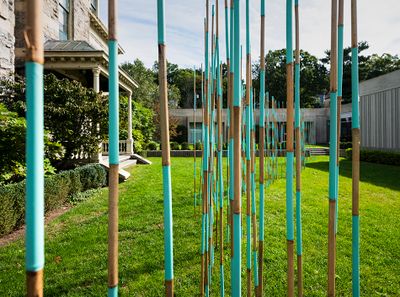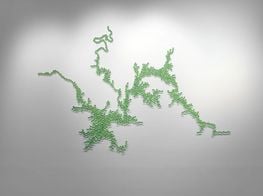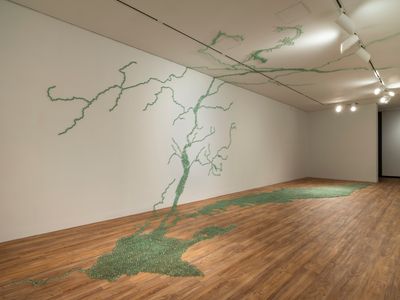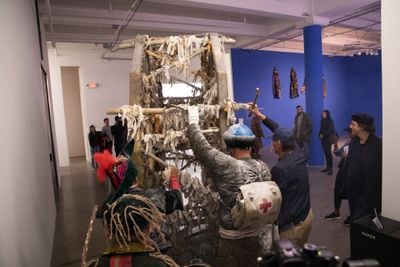Asia Contemporary Art Week: Diary #5: 11–17 October 2018
In collaboration with Asia Contemporary Art Week
Far from slowing down, the sixth week of Asia Contemporary Art Week continues to explore and unravel the rich possibilities of 'thinking collections', bringing together a variety of artists, filmmakers, and institutions in transnational and cross-disciplinary dialogue. Together, 'Asian-ness' is not deployed as a homogenising concept, but rather an open-ended container that sheds light on inherited biases in our perception, different modes of spirituality, and ambiguous spaces located outside the museum context.

Maya Lin, Reed River (detail) (2018). Bamboo, paint, and grass seed. Exhibition view: _Maya Lin: A River Is a Drawing, _Hudson River Museum (12 October 2018–20 January 2019). Courtesy the artist. Photo: Kris Graves.
The week commenced with Egyptian filmmaker Tamer El Said's documentary-fiction film In the Last Days of the City, which was organised by ArteEast (a New York-based non-profit that supports Middle Eastern art) and screened at Union Docs in Brooklyn on 11 October. Taking ten years to complete, the film is both a love letter to Cairo—in that it is a prolonged experiment to capture the city's texture and vibrancy—and the artist's self-portrait. The film focuses on the protagonist's (played by Khalid Abdalla) lengthy filmmaking project and journey to self-discovery which mirror Said's own experiences. In the Q&A session which followed the screening, Said explained that since he finished filming just before the eruption of the Egyptian Revolution in 2011, Western commentators tended to view the film solely through ideologically-charged lens. Yet, he elaborated, to do so would collapse the multi-dimensionality and subtlety that characterise the film.
If film allows Said to zoom in on the nuances of a city's urban fabric, data visualisation gives Maya Lin a means to bridge the Hudson River and the poetic fluidity of drawing. On 12 October, the artist-designer's solo project A River is a Drawing (12 October 2018–January 20 2019) opened at the Hudson River Museum in the City of Yonkers, Westchester County. Rocketed to international fame for designing Washington, D.C.'s Vietnam Veterans Memorial in as an undergraduate student, Lin has dedicated herself to gathering information from geological surveys to stage installations with which viewers can interact. A range of site-specific sculptures are distributed among the museum's permanent collection; while some are laboriously fashioned out of pins, glass marbles, or colorful bamboo reeds, one work named Concrete River (2018) is made by pouring silver paint into cracks that already exist on an outdoor terrace—a whimsical act compared to the more data-driven methods of artmaking.
Compared to Lin's large-scale, bird's eye view approach, Yasumasa Morimura's performance Nippon Cha Cha Cha! takes the form of an extremely intimate encounter with the audience. Taking place in conjunction with Yasumasa Morimura: Ego Obscura, the artist's solo exhibition at Japan Society (12 October 2018–13 January 2019), the multi-media performance shows him transforming from a Marilyn Monroe-like character to post-war Japanese literary icon Yukio Mishima, even stripping down to his underwear. As Morimura reads with vehemence from a scroll, donning military garb, he demonstrates satirical takes on Mishima's rigid masculinity and nationalist sentiments, while comically voicing grievances against the pretenses of contemporary art.
On 14 October, ACAW's signature exhibition entitled Thinking Collections: Telling Tales opened amidst bustling crowds at Mana Contemporary, Jersey City. Part of Focus Kazakhstan (an international exhibition project initiated by The National Museum of Republic of Kazakhstan), it is framed as an ambitious survey of works produced by Kyzyl Tractor, an eclectic art collective from Kazakhstan. In the attempt to highlight the act of collecting as a self-conscious artistic practice, the exhibition takes a rather unconventional approach by cramming over 300 artworks into a tight space. One section mimics the studio of Moldakul Narymbetov, a key figure in Kyzyl Tractor, showcasing his experimentations with various European styles and movements of the 20th century; while another wall is devoted to a sprawling body of archival materials documenting the collective's largely outdoor performances. At the same time, a number of sculptural objects produced from materials such as animal hide, fabric, and rubber are strewn in the middle of the gallery. These varied yet interrelated modes of display make for a challenging and chaotic viewing experience; here, objects take on manifold identities—they are simultaneously sacred artworks, functional instruments, and remnants of ephemeral happenings.
At 3pm during the opening for the exhibition, the group, dressed in traditional costumes referencing the roles of doctors and healers, took to Mana's courtyard and started rolling around a gigantic drum, all the while performing a purification ritual. Entrancing the audience, this visceral, spiritually-charged, and infectious procession continued all the way back to the building's main hall. The members of Kyzyl Tractor, as self-appointed nomads, shamans, and poets steeped in Sufi philosophy, present a way of identifying with the world that is radically different from a Western ontology built upon reason and disembodiment—one that dissolves the barrier between man, nature, and the divine.
As a part of its Arab Art and Education Initiative, MoMA hosted a video screening and conversation with Kuwaiti artist Monira al Qadiri on 15 October. Her practice interrogates gender, petroculture, and the aesthetics of melancholy. Made within the last five years, these short videos humorously point to power structures in the Gulf region which are either familial or reinforced by popular media. Soap (2014), for example, depicts female domestic workers photoshopped onto clips from Arab soap operas, cleaning up the mess made by exaggerated patriarchal figures, whereas Father of Pain (2013) features the artist dressing in drag to play the role of the Iraqi singer Yas Khodhor, performing a type of male sadness that is absurd and obsolete.
In all, this week's programming invites us to reflect on the use of gender reversal and masquerade to deconstruct tropes of representation, as demonstrated by Morimora and al Qadiri's performative strategies, and the necessary breakdown between nature and the self in face of shared calamity, as seen in Lin's efforts to underscore the significance of water to human survival and industry. It further raises the question: could transgressive, transient, and multi-layered practices such as Kyzyl Tractor's be contained in a format of display that privileges the static object and the sacredness of archives? —[O]













































































































































































